Preliminary results of the Pension Satellite Account, 1990 to 2007
Archived Content
Information identified as archived is provided for reference, research or recordkeeping purposes. It is not subject to the Government of Canada Web Standards and has not been altered or updated since it was archived. Please "contact us" to request a format other than those available.
Printable version (PDF) of this article (PDF, 64 KB)
Introduction
In this first release, a time series of pension assets by type are made available as an extension to the National Balance Sheet Accounts. The pension asset table covers the entire universe of the retirement regime in Canada which includes government-sponsored social security, employer-sponsored pension plans (ESPP)1, and individual registered saving plans (IRSP). Estimates of pension assets are taken from the National Balance Sheet Accounts (NBSA) to a large extent. Details of pension assets not explicitly shown in the NBSA were developed using other Statistics Canada data sources such as Trusteed Pension Fund surveys, the Survey of Financial Security in Canada and the Quarterly Survey of Financial Statements. In addition, survey data from the Canadian Life and Health Insurance Association and results from the Canadian Financial Monitor survey from Ipsos-Reid were used.
Table 1 Pension assets by type of plan at market value
Pension assets by type of plan
Total assets of the pension programs account for $2.1 trillion at year-end 2007 (Chart 1), or 38% of National Net Worth. This figure includes assets of the personal sector, both group and individual plans, in addition to a smaller portion of accumulated pension assets in the government sector (for the Canada and Quebec Pension Plans).
Chart 1
Assets of Canada's pension system,
at market value
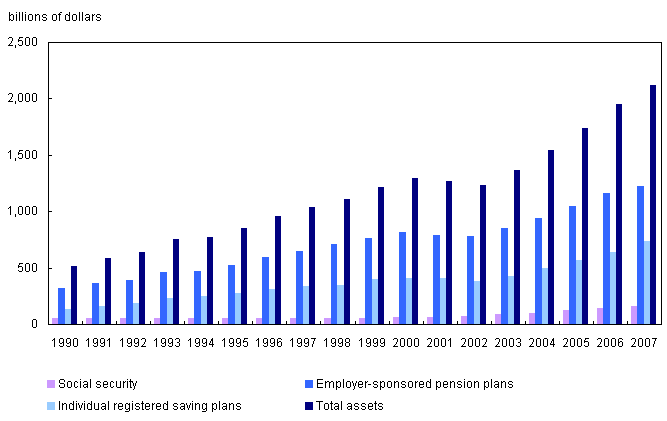
The bulk of the Canadian pension system assets constitute part of personal sector net worth, and this amount has quadrupled since 1990. In 2007, pension assets excluding social security represent a third of the net worth of the persons and unincorporated business sector (Chart 2).
Chart 2
Comparison between pension assets and net worth of persons and
unincorporated business, at market value
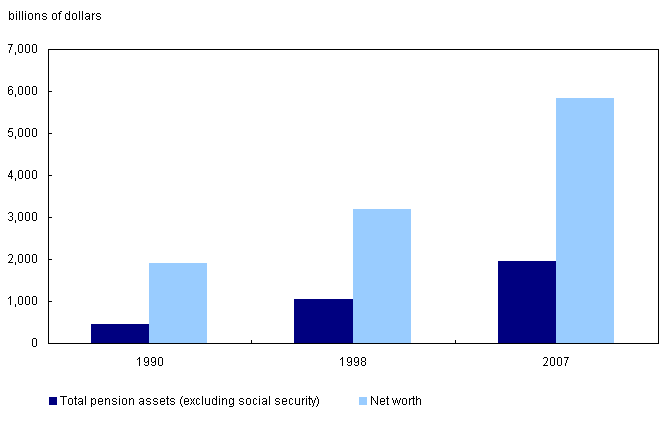
The three tiers of the pension system
In Canada, there are a range of social programs and saving schemes designed to provide sources of funds for retirement. These include social security, employer-sponsored pension plans, and individual registered saving plans which are tax-sheltered to encourage individuals to accumulate assets for use as a source of funds for retirement.
Social security
Social security in the System of National Accounts is differentiated from employer-sponsored plans because with social security plans there is a relationship with the government rather than the employer. For the Canada Pension Plan (CPP) and the Quebec Pension Plan, the assets are recorded in the government sector2. There is no government liability recognised as an asset in the personal sector for these social programs. The benefit payments to individuals are recorded as inflows to personal sector income through transfers from the government sector.
In December 1997, amendments were brought to the CPP. This included a new schedule of contribution rates and the creation of the Canada Pension Plan Investment Board, whose purpose is to maximise returns on investments without undue risk in order to keep the plan sustainable in the long term while minimising the burden on future generations. The upswing in market value of CPP assets after 1999 (Chart 3) reflects both the increased contribution rates and the market return on the investments that have been made by the Canada Pension Plan Investment Board since March 1999.
Chart 3
Pension assets in social security by type, at market value
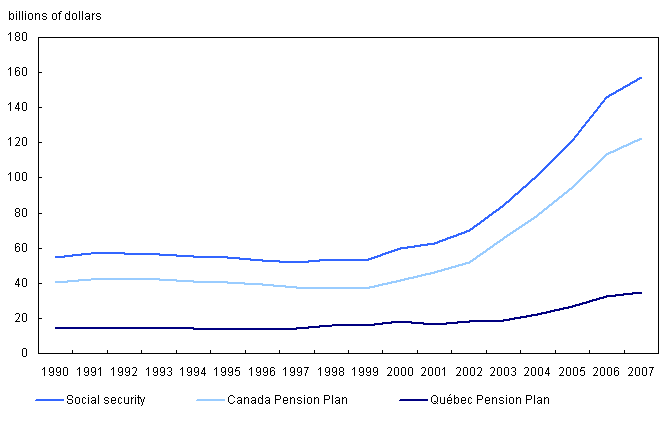
Employer-sponsored plans
Employer-sponsored plans or registered pension plans are dominated by trusteed pension plans, which make up three quarters of all employer-sponsored pension assets. Registered pension plans can also be administered through insurance company contracts which operate in much the same manner as trusteed pension plans.
Most of the remaining assets are obligations (liabilities) under government consolidated revenue arrangements administered by the federal government and some provincial governments. Deferred profit arrangements and other retirement arrangements such as the now-terminated government annuities program make up the balance of the registered pension plans (Chart 4). Each of these types of plans represents assets of the personal sector.
Chart 4
Pension assets in employer-sponsored plans by type, at market
value
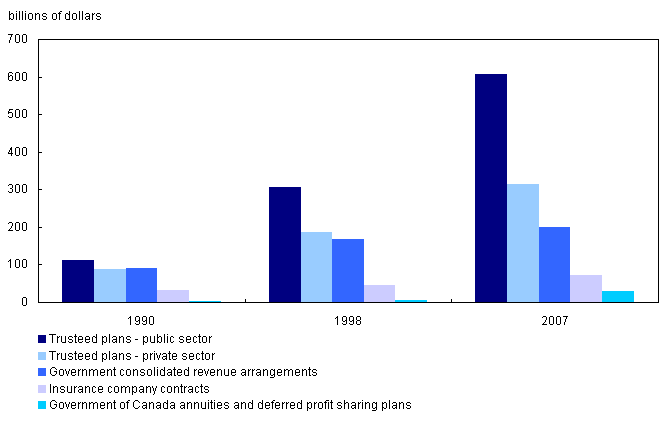
Public sector pensions make up over 65% all employer-sponsored pension assets. This includes both public sector trusteed plans with invested assets as well as the government consolidated revenue arrangements (non-autonomous plans). Consolidated revenue plans have no separately invested assets. Consolidated revenue plans have increasingly become funded over time3.
Deferred profit sharing plans (DPSP) are arrangements whereby the employer contributions to the plan are calculated by reference to the employer's profits. Contributions are paid to a trustee, usually a Canadian trust or life insurance company, who holds and invests the contributions for employees.
Individual registered saving plans
Individual registered saving plans (IRSP) were introduced in 1957. Contributions to Registered Retirement Savings Plans (RRSPs) are voluntary and are tax-sheltered with the maximum contribution depending on income as well as contributions to other registered pension plans. Withdrawals are allowed but subject to income tax at the time of withdrawal. The accumulated amount must be converted to payout vehicles such as registered retirement income funds (RRIF) or an annuity prior to the end of the year in which taxpayer's 71st birthday is reached.
Assets for IRSPs are recorded as assets in the personal sector. These are also reflected as liabilities of the corporate sector, governments or non-residents, depending on what type of instrument the assets are invested. Assets under IRSPs have grown rapidly, particularly since the 1991 changes to the Income Tax Act that increased contribution limits. There has been a marked shift from RRSP interest-bearing deposits to other types of investments which rely more on asset-appreciation as a source of growth. From 2002 onwards, the share of IRSPs invested in other types of plans, including self-directed RRSPs offering more diversified investment options, has grown significantly (Chart 5).
Chart 5
Pension assets in individual registered saving plans by type,
at market value
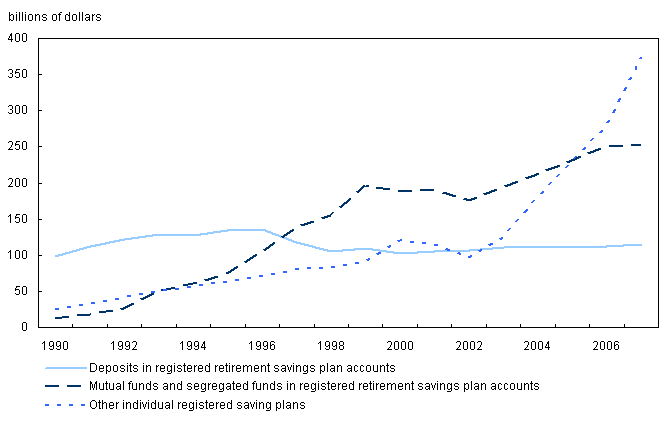
Summary and future work
This first release of pension assets has described the size and composition of pension assets in Canada. Such wealth measures have become increasingly relevant indicators of the evolution of personal net worth, as well as of the pension system as a whole.
Although pension flows and stocks are accounted for within the Canadian System of National Accounts (CSNA), they are sometimes embedded in the various aggregates of the macro-economic accounting system and are not fully articulated.
The Pension Satellite Account (PSA) is an articulation and extension of the stock-flow dimension of the core accounts. The PSA basic framework, in condensed form, is shown in Figure 1 below, with opening and closing wealth positions along with inflows and outflows which highlight the key components of wealth change. The PSA is a detailed three-dimensional matrix, with the third dimension being time series.
Figure 1
Stock-flow matrix presentation of the pension satellite account

Following this first release of a time series of pension assets, or wealth positions in Figure 1 by type, subsequent releases of the PSA will link pension stocks and flows, integrated into a complete and coherent framework. The PSA project is largely analytical in nature. As development of these provisional estimates progresses, the estimates may be revised and broadened in scope.
References
- National Balance Sheet Accounts, Statistics Canada catalogue no. 13-214.
- Morneau Sobeco Handbook of Canadian Pension and Benefit Plans (2005), edited by Matthew Tierney and Anny Vexler, revised by the professionals at Morneau Sobeco, 13th edition, CCH Canadian Limited, Toronto.
Notes:
1. Employer-sponsored plans include
some plans that are co-sponsored by employees associations.
2. Although the Old Age Security program
is included in the social security category of pensions, there are
no assets associated to this program.
3. For example, after
April 2000, the net amount of contributions less benefits
and payments related to the Federal Public Service, Canadian
Forces and Royal Canadian Mounted Police (RCMP) pension
plans were transferred to the Public Sector Pension Investment
Board.
- Date modified:
